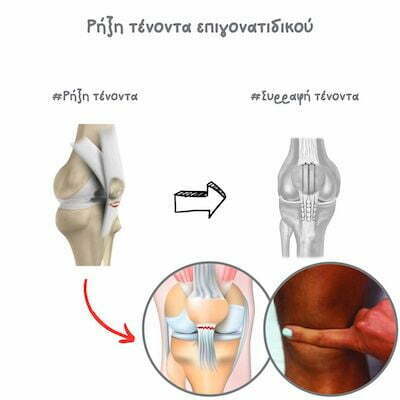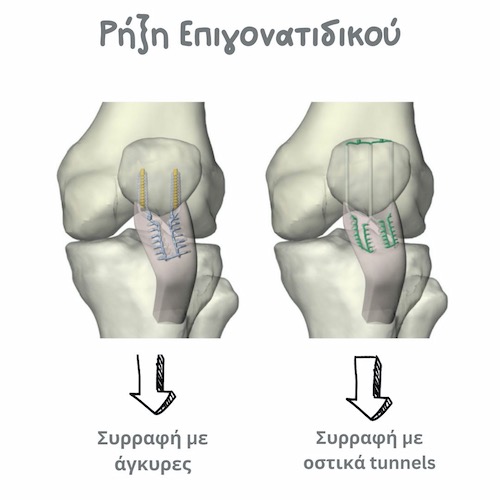Georgios Panagopoulos MD | Orthopaedic Surgeon

Table of contents
What is a patellar tendon tear?
The patellar tendon connects the kneecap (patella) with the leg bone (tibia) and its function, along with the quadriceps tendon, is to straighten the knee. A patellar tendon can rupture as a result of sports injuries, accidents at home or car accidents. A complete tear occurs when the patellar tendon is completely separated from the kneecap.

What causes a patellar tendon tear?
A patellar tendon tear can be caused by injuries at home, such as a fall from height directly onto the knee, or a jump with awkward landing. It can also be a result of a sport injury or a consequence of a road traffic accident. It is also common in patients with diseases that disrupt the blood supply, which weakens the tendon overall, predisposing it to rupture with minimal trauma. These conditions include diabetes, chronic kidney failure (especially if on dialysis), rheumatoid arthritis or lupus, etc. Steroid use can also lead to tendon weakness.
Η ρήξη του επιγονατιδικού είναι λιγότερο συχνή από τη ρήξη του τετρακεφάλου, ενώ εμφανίζεται περισσότερο στους άνδρες.
Διάφοροι παράγοντες μπορεί να συντελέσουν στη ρήξη, όπως:
- Chronic renal failure
- Dialysis
- Hyperparathyroidism
- Gout
- Leukemia
- Rheumatoid arthritis
- Lupus
- Diabetes mellitus
- Infection
- Metabolic syndrome
- Steroid use
- Prolonged immobilisation
- Quinolones
What are the symptoms of a patellar tendon tear?
Τα συμπτώματα περιλαμβάνουν έντονο πόνο τη στιγμή της ρήξης, τον οποίο ακολουθεί πρήξιμο και δυσχέρεια βάδισης. Ο ασθενής δεν μπορεί να βαδίσει και προσέρχεται στο ιατρείο υποβασταζόμενος. Υπάρχει απώλεια μυϊκού τόνου. Συνήθως είναι εμφανές ή ψηλαφάται ένα κενό ακριβώς κάτω από την επιγονατίδα. Ο ασθενής παρουσιάζει αδυναμία ανύψωσης του τεντωμένου άκρου (positive straight leg raise test – SLR +).
Diagnosis
Ο ιατρός θα πάρει αναλυτικό ιστορικό και θα σας εξετάσει προσεκτικά. Μία ακτινογραφία γόνατος θα αποκλείσει την ύπαρξη συνοδών καταγμάτων και θα δείξει παθολογική ανύψωση της επιγονατίδας (patella alta). Η ύπαρξη ή αίσθηση ψηλαφητού κενού είναι χαρακτηριστική της πάθησης, και συνήθως θέτει την υποψία για περαιτέρω απεικονιστικό έλεγχο. Η βλάβη συνήθως επιβεβαιώνεται με τη βοήθεια υπέρηχου ή μαγνητικής τομογραφίας.

Treatment
Most people with a complete tear of the patellar tendon require surgery to regain their function. Surgery is done on an outpatient basis, which means that you may go home a few hours after the procedure if you wish. Your surgeon will typically place sutures in your tendon, will pass those sutures through drill holes on top of the patella and tie them. Alternatively, your surgeon can use suture anchors instead of tunnels.
Αν η ρήξη είναι μερική και όχι πλήρης, μπορεί υπό προϋποθέσεις να εφαρμοστεί συντηρητική θεραπεία, με ακινητοποίηση για κάποιο διάστημα.
Ρήξη Επιγονατιδικού τένοντα: Αποκατάσταση
Your knee will be protected for a few weeks with a knee immobilizer, with an intent to fully weight bear after 6 weeks. A rehabilitation plan will be customized for you by your doctor and physical therapist.

FAQs - Frequently Asked Questions
What is a patellar tendon tear?
The patellar tendon connects the kneecap (patella) with the leg bone (tibia) and its function, along with the quadriceps tendon, is to straighten the knee. A patellar tendon can rupture as a result of sports injuries, accidents at home or car accidents.
What are the symptoms?
– Έντονος πόνος
– Απώλεια μυϊκού τόνου
– Οίδημα – πρήξιμο
– Ψηλαφητό κενό
– Αδυναμία ανύψωσης του τεντωμένου άκρου (positive straight leg raise test, o SLR)
How is diagnosis made?
– History & clinical exam
– X-rays
– Ultrasound
– MRI
What's the treatment?
Η θεραπεία είναι στη συντριπτική πλειοψηφία των περιπτώσεων χειρουργική, με συρραφή του τένοντα και επανακαθήλωσή του στην επιγονατίδα μέσω αστικών τούνελ.
Find us
Book an appointment with us today
